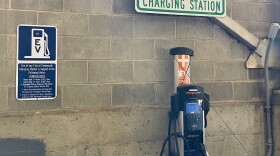Transportation infrastructure is a perennial issue in the Granite State: from aging bridges to annoying potholes to highways and byways in need of repair. Now, Governor Sununu's budget includes an Infrastructure Revitalization Fund that sends money to communities to address this. And President Trump has promised a major effort as well.
GUESTS:
- Logan Johnson - Civil Engineer who serves on the Board of Directors of the New Hampshire Chapter of the American Society of Civil Engineers.
- Victoria Sheehan - Commissioner of the New Hampshire Department of Transportation.
You can read the 2013 New Hampshire Infrastructure Report Card from the American Society of Civil Engineers here. The new report for 2017 will be released in April.
Check out the N.H. Department of Transportation website for updates on current projects.
Highlights from the conversation:
Both Sheehan and Johnson acknowledge that many roads and bridges in New Hampshire are in poor condition, but that it is difficult to decide where to invest for the best long-term results. Sheehan says that deferring investment on roads that need regular repairs is more costly in the long run than maintaining well-cared for roads.
When we defer investment, it can cost three or four times as much to get back to the same level condition. So, for example, if we can keep up with pavement conditioning, doing pavement preservation treatments, that's a much lower cost in maintaining the infrastructure. Once [roads have] deteriorated, to do a full reconstruction or rehabilitation can cost a lot more money to the taxpayer. We are so underfunded at times, we make those per investment choices that end up costing more in the long run.
Johnson agrees that investing in already-good roads and bridges is better for saving money in the future. She also says that the roads that have the most damage are "low-tier" roads.
For a long time, we've been working on our larger roads, and deferring these lower-tiered roads, and currently, it seems like...the worst roads are kind of the lower tiers.
Sheehan says the tier system is based on the amount of traffic a road gets.
Tier one is our interstates and divided highways. Those are high volume roadways. And then we have tier two, tier three, and tier four. With tier four, we consider those to be lower tier roads with low volume, serving more of the local traffic. And we have been investing significantly in our higher volume roadways, prioritizing those, because poor conditions would impact more motorists.
One listener was curious about how federal funding is used in transportation infrastructure. Johnson says that New Hampshire relies heavily on federal funds, but that they are insufficient for the amount of work that needs to be done.
Sheehan says that federal money for infrastructure only applies to certain roads, and as a result, these are often better maintained.
Not all roads in New Hampshire are eligible for those federal funds. We have around 3400 lane miles that are federal aid eligible, but we have an additional 1140 lane miles that are non-federal aid eligible. The federal funding is really prioritized for the national highway system and roads that really impact commerce.
As a result, she says, state funds go more towards the roads that cannot use federal funds, but that these state funds don't cover the cost it takes to maintain all of these roads.
Many listeners wanted to know about commuter rail in the Granite State. During the campaign, Governor Sununu's Democratic opponent, Colin Van Ostern, was in favor of rail development. The Governor would rather funds be used to improve already existing transportation routes.
The New Hampshire Department of Transportation creates a 10-year plan, which is revised every two years. This year, rail was eliminated from the 10-year plan.
As a department we really pride ourselves on listening to what constituents are asking for, and we're fortunate in New Hampshire to have a 10-year plan process where we do go out into the communities and solicit input on what our priorities should be.
This year, she says, the election and feedback from the Executive Council demonstrates that constituents are not as invested in rail as they are in other road projects.
Sheehan and Johnson also discussed the impact of climate change, severe weather, and wildlife on road development.








